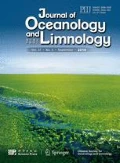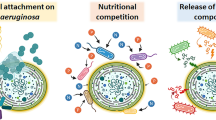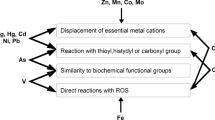Abstract
The increasing occurrence of cyanobacterial blooms in water bodies is a serious threat to the environment. Efficient in-lake treatment methods for the control of cyanobacteria proliferation are needed, their in-vivo detection to obtain a real-time response to their presence, as well as the information about their physiological state after the applied treatment. In-vivo fluorescence measurements of photosynthetic pigments have proved to be effective for quantitative and qualitative detection of phytoplankton in a water environment. In the experiment, chlorophyll and phycocyanin fluorescence sensors were used concurrently to detect stress caused by electrochemical oxidation applying an electrolytic cell equipped with borondoped diamond electrodes on a laboratory culture of cyanobacteria Microcystis aeruginosa PCC 7806. The inflicted injuries were reflected in a clear transient increase in the phycocyanin fluorescence signal (for 104 %± 43%) 24 h after the treatment, which was not the case for the chlorophyll fluorescence signal. In the next 72 h of observation, the fluorescence signals decreased (on 40% of the starting signal) indicating a reduction of cell number, which was confirmed by cell count (24% reduction of the starting concentration) and analysis of extracted chlorophyll and phycocyanin pigment. These results demonstrate the viability of the combined application of two sensors as a useful tool for in-vivo detection of induced stress, providing real-time information needed for the evaluation of the efficiency of the in-lake treatment and decision upon the necessity of its repetition. The electrochemical treatment also resulted in a lower free microcystins concentration compared to control.
Similar content being viewed by others
References
Antoniou M G, Shoemaker J A, De La Cruz A A, Dionysiou D D. 2008. Unveiling new degradation intermediates/pathways from the photocatalytic degradation of microcystin-LR. Environmental Science & Technology, 42 (23): 8 877–8 883.
Barrington D J, Ghadouani A. 2008. Application of hydrogen peroxide for the removal of toxic cyanobacteria and other phytoplankton from wastewater. Environmental Science & Technology, 42 (23): 8 916–8 921, https://doi.org/10.1021/es801717y.
Barrington D J, Reichwaldt E S, Ghadouani A. 2013. The use of hydrogen peroxide to remove cyanobacteria and microcystins from waste stabilization ponds and hypereutrophic systems. Ecological Engineering, 50: 86–94. https://doi.org/10.1016/j.ecoleng.2012.04.024.
Bastien C, Cardin R, Veilleux É, Deblois C, Warren A, Laurion L. 2011. Performance evaluation of phycocyanin probes for the monitoring of cyanobacteria. Journal of Environment Monitoring, 13 (1): 110–118, https://doi.org/10.1039/c0em00366b.
Beutler M, Wiltshire K H, Meyer B, Moldaenke C, Lüring C, Meyerhöfer M, Hansen U P, Dau H. 2002. A fluorometric method for the differentiation of algal populations in-vivo and in situ. Photosynthesis Research, 72 (1): 39–53, https://doi.org/10.1023/a:1016026607048.
Boopathi T, Ki J S. 2014. Impact of environmental factors on the regulation of cyanotoxin production. Toxins, 6 (7): 1 951–1 978, https://doi.org/10.3390/toxins6071951.
Brooks B W, Lazorchak J M, Howard M D A, Johnson M V V, Morton S L, Perkins D A K, Reavie E D, Scott G I, Smith S A, Steevens J A. 2016. Are harmful algal blooms becoming the greatest inland water quality threat to public health and aquatic ecosystems? Environmental Toxicology and Chemistry, 35 (1): 6–13, https://doi.org/10.1002/etc.3220.
Bryant D A. 1987. The cyanobacterial photosynthetic apparatus: comparison to those of higher plants and photosynthetic bacteria. Canadian Bulletin of Fisheries and Aquatic Science, 214: 423–500.
Cabeza, A, Urtiaga A M, Ortiz I. 2007. Electrochemical treatment of landfill leachates using a boron-doped diamond anode. Industrial & Engineering Chemistry Research, 46 (5): 1 439–1 446, https://doi.org/10.1021/ie061373x.
Campbell D, Hurry V, Clarke A K, Gustafsson P, Öquist G. 1998. Chlorophyll fluorescence analysis of cyanobacterial photosynthesis and acclimation. Microbiology and Molecular Biology Reviews, 62 (3): 667–683.
Carmichael W W. 1992. Cyanobacteria secondary metabolites-the cyanotoxins. Journal of Applied Bacteriology, 72 (6): 445–459, https://doi.org/10.1111/j.1365-2672.1992.tb01858.x.
Chang D W, Hobson P, Burch M, Lin T F. 2012. Measurement of cyanobacteria using in-vivo-fluoroscopy—effect of cyanobacterial species, pigments, and colonies. Water Research, 46 (16): 5 037–5 048, https://doi.org/10.1016/j.watres.2012.06.050.
Chen G H. 2004. Electrochemical technologies in wastewater treatment. Separation and Purification Technology, 38 (1): 11–41, https://doi.org/10.1016/j.seppur.2003.10.006.
Chorus I, Bartram J. 1999. Toxic Cyanobacteria in water: a guide to their public health consequences, monitoring and management. E&FN Spon, London.
Cornish B J P A, Lawton L A, Robertson P K J. 2000. Hydrogen peroxide enhanced photocatalytic oxidation of microcystin-LR using titanium dioxide. Applied Catalysis B: Environmental, 25 (1): 59–67, https://doi.org/10.1016/S0926-3373(99)00121-6.
da Silva L M, Santana M H P, Boodts J F C. 2003. Electrochemistry and green chemical processes: electrochemical ozone production. Química Nova, 26 (6): 880–888, https://doi.org/10.1590/S0100-40422003000600017.
Daghrir R, Drogui P, Tshibangu J. 2014. Efficient treatment of domestic wastewater by electrochemical oxidation process using bored doped diamond anode. Separation and Purification Technology, 131: 79–83. https://doi.org/10.1016/j.seppur.2014.04.048.
Ding Y, Gan N Q, Li J, Sedmak B, Song L R. 2012. Hydrogen peroxide induces apoptotic-like cell death in Microcystis aeruginosa (Chroococcales, Cyanobacteria) in a dosedependent manner. Phycologia, 51: 567–575. https://doi.org/10.2216/11-107.1.
Ding Y, Song L R, Sedmak B. 2013. UVB radiation as a potential selective factor favoring microcystin producing bloom forming cyanobacteria. PLoS One, 8 (9): e73919, https://doi.org/10.1371/journal.pone.0073919.
Drábková M, Admiraal W, Maršálek B. 2007. Combined exposure to hydrogen peroxide and light-selective effects on cyanobacteria, green algae, and diatoms. Environmental Science & Technology, 41 (1): 309–314, https://doi.org/10.1021/es060746i.
Falconer I R. 1989. Effects on human health of some toxic cyanobacteria (blue-green algae) in reservoirs, lakes, and rivers. Toxicity Assessment, 4 (2): 175–184, https://doi.org/10.1002/tox.2540040206.
Frontistis Z, Brebou C, Venieri D, Mantzavinos D, Katsaounis A. 2011. BDD anodic oxidation as tertiary wastewater treatment for the removal of emerging micro-pollutants, pathogens and organic matter. Journal of Chemical Technology and Biotechnology, 86 (10): 1 233–1 236, https://doi.org/10.1002/jctb.2669.
Fujita Y. 1979. Qualitative and quantitative methods of photosynthetic pigments. In: Nishizawa K, Chihara M eds. Methods in Phycological Studies (Japanese). Kyouritsu Shuppan, Tokyo. p.474–507.
Gantt E, Lipschultz CA, Grabowski J, Zimmerman B K. 1979. Phycobilisomes from blue-green and red algae. Plant Physiology, 63 (4): 615–620.
García-Montoya M F, Gutiérrez-Granados S, Alatorre-Ordaz A, Galindo R, Ornelas R, Peralta-Hernández J M. 2015. Application of electrochemical/BDD process for the treatment wastewater effluents containing pharmaceutical compounds. Journal of Industrial and Engineering Chemistry, 31: 238–243. https://doi.org/10.1016/j.jiec.2015.06.030.
Gregor J, Maršálek B, Šípková H. 2007. Detection and estimation of potentially toxic cyanobacteria in raw water at the drinking water treatment plant by in vivofluorescence method. Water Research, 41 (1): 228–234, https://doi.org/10.1016/j.watres.2006.08.011.
Gregor J, Maršálek B. 2004. Freshwater phytoplankton quantification by chlorophyll a: A comparative study of in vitro, in vivo and in situ methods. Water Research, 38 (3): 517–522, https://doi.org/10.1016/j.watres.2003.10.033.
Haaken D, Dittmar T, Schmalz V, Worch E. 2012. Influence of operating conditions and wastewater-specific parameters on the electrochemical bulk disinfection of biologically treated sewage at boron-doped diamond (BDD) electrodes. Desalination and Water Treatment, 46 (1–3): 160–167, https://doi.org/10.1080/19443994.2012.677523.
Harada K I, Tsuji K. 1998. Persistence and decomposition of hepatotoxic microcystins produced by cyanobacteria in natural environment. Journal of Toxicology-Toxin Reviews, 17 (3): 385–403, https://doi.org/10.3109/15569549809040400.
Hilton J, Rigg E, Jaworski G. 1989. Algal identification using in-vivo-fluorescence spectra. Journal of Plankton Research, 11(1): 65–74.
ISO. 1992. Water quality-measurement of biochemical parameters-spectrometric determination of the chlorophyll-a concentration: ISO 10260: 1992. Geneva, Switzerland: International Organization for Standardization.
Jančula D, Maršálek B. 2011. Critical review of actually available chemical compounds for prevention and management of cyanobacterial blooms. Chemosphere, 85 (9): 1 415–1 422, https://doi.org/10.1016/j.chemosphere.2011.08.036.
Jones G J, Orr P T. 1994. Release and degradation of microcystin following algicide treatment of a Microcystis aeruginosa bloom in a recreational lake, as determined by HPLC and protein phosphatase inhibition assay. Water Research, 28 (4): 871–876, https://doi.org/10.1016/0043-1354(94)90093-0.
Lacasa E, Tsolaki E, Sbokou Z, Rodrigo M A, Mantzavinos D, Diamadopoulos E. 2013. Electrochemical disinfection of simulated ballast water on conductive diamond electrodes. Chemical Engineering Journal, 223: 516–523. https://doi.org/10.1016/j.cej.2013.03.003.
Lee T, Tsuzuki M, Takeuchi T, Yokoyama K, Karube I. 1994. In-vivo-fluorometric method for early detection of cyanobacterial waterblooms. Journal of Applied Phycology, 6 (5–6): 489–495.
Liao W J, Murugananthan M, Zhang Y R. 2014. Electrochemical degradation and mechanistic analysis of microcystin-LR at boron-doped diamond electrode. Chemical Engineering Journal, 243: 117–126. https://doi.org/10.1016/j.cej.2013.12.091.
Macário I P E, Castaro B B, Nunes M I S, Antunes S C, Pizarro C, Coelho C, Gonçalves F, de Figueiredo D R. 2015. New insights towards the establishment of phycocyanin concentration thresholds considering species-specific variability of bloom-forming cyanobacteria. Hydrobiologia, 757 (1): 155–165.
Martínez-Huitle C A, Brillas E. 2009. Decontamination of wastewaters containing synthetic organic dyes by electrochemical methods: a general review. Applied Catalysis B: Environmental, 87 (3–4): 105–145, https://doi.org/10.1016/j.apcatb.2008.09.017.
Martins J, Peixe L, Vasconcelos V M. 2011. Unraveling cyanobacteria ecology in wastewater treatment plants (WWTP). Microbial Ecology, 62 (2): 241–256, https://doi.org/10.1007/s00248-011-9806-y.
Matthijs H C P, Visser P M, Reeze B, Meeuse J, Slot P C, Wijn G, Talens R, Huisman J. 2012. Selective suppression of harmful cyanobacteria in an entire lake with hydrogen peroxide. Water Research, 46 (5): 1 460–1 472, https://doi.org/10.1016/j.watres.2011.11.016.
Meglič A, Pecman A, Rozina T, Leštan D, Sedmak B. 2017. Electrochemical inactivation of cyanobacteria and microcystin degradation using a boron-doped diamond anode-A potential tool for cyanobacterial bloom control. Journal of Environmental Sciences, 53: 248–261. https://doi.org/10.1016/j.jes.2016.02.016.
Meriluoto J, Spoof L, Codd G A. 2017. Handbook of Cyanobacterial Monitoring and Cyanotoxin Analysis. Wiley, New York. 576p.
Oldham P B, Zillioux E J, Warner I M. 1985. Spectral “fingerprinting” of phytoplankton populations by twodimensional fluorescence and Fourier-transform-based pattern recognition. Journal of Marine Research, 43 (4): 893–906.
Paerl H W, Hall N S, Calandrino E S. 2011. Controlling harmful cyanobacterial blooms in a world experiencing anthropogenic and climatic-induced change. Science of the Total Environment, 409 (10): 1 739–1 745.
Paerl H W, Otten T G. 2013. Harmful cyanobacterial blooms: causes, consequences, and controls. Microbial Ecology, 65 (4): 995–1 010, https://doi.org/10.1007/s00248-012-0159-y.
Pryor W A. 1986. Oxy-radicals and related species: their formation, lifetimes, and reactions. Annual Review of Physiology, 48: 657–667.
Rozina T, Sedmak B, Zupančič Justin M, Meglič A. 2017. Evaluation of cyanobacteria biomass derived from upgrade of phycocyanin fluorescence estimation. Acta Biologica Slovenica, 60(2): 21–28.
Samuilov V D, Timofeev K N, Sinitsyn S V, Bezryadnov D V. 2004. H2O2-induced inhibition of photosynthetic O2 evolution by Anabaena variabilis cells. Biochemistry (Moscow), 69 (8): 926–933, https://doi.org/10.1023/B:BIRY.0000040227.66714.19.
Schmalz V, Dittmar T, Haaken D, Worch E. 2009. Electrochemical disinfection of biologically treated wastewater from small treatment systems by using borondoped diamond (BDD) electrodes-contribution for direct reuse of domestic wastewater. Water Research, 43 (20): 5 260–5 266, https://doi.org/10.1016/j.watres.2009.08.036.
Sedmak B, Carmeli S, Pompe-Novak M, Tušek-Žnidarič M, Grach-Pogrebinsky O, Eleršek T, Žužek M C, Bubik A, Frangež R. 2009. Cyanobacterial cytoskeleton immunostaining: the detection of cyanobacterial cell lysis induced by planktopeptin BL1125. Journal of Plankton Research, 31 (11): 1 321–1 330, https://doi.org/10.1093/plankt/fbp076.
Seppälä J, Ylöstalo P, Kaitala S, Hällfors S, Raateoja M, Maunula P. 2007. Ship-of-opportunity based phycocyanin fluorescence monitoring of the filamentous cyanobacteria bloom dynamics in the Baltic Sea. Estuarine, Coastal and Shelf Science, 73 (3–4): 489–500.
Sharma V K, Triantis T M, Antoniou M G, He X X, Pelaez M, Han C, Song W H, O’Shea K E, de la Cruz A A, Kaloudis T, Hiskia A, Dionysiou D D. 2012. Destruction of microcystins by conventional and advanced oxidation processes: a review. Separation and Purification Technology, 91: 3–17. https://doi.org/10.1016/j.seppur.2012.02.018.
Svirčev Z, Drobac D, Tokodi N, Mijović B, Codd G A, Meriluoto J. 2017. Toxicology of microcystins with reference to cases of human intoxications and epidemiological investigations of exposures to cyanobacteria and cyanotoxins. Archives of Toxicology, 91 (2): 621–650, https://doi.org/10.1007/s00204-016-1921-6.
Tsuji K, Watanuki T, Kondo F, Watanabe M F, Nakazawa H, Suzuki M, Uchida H, Harada K I. 1997. Stability of microcystins from cyanobacteria-iv. effect of chlorination on decomposition. Toxicon, 35 (7): 1 033–1 041.
van Hullebusch E D, Zandvoort M H, Lens P N L. 2003. Metal immobilisation by biofilms: mechanisms and analytical tools. Reviews in Environmental Science and Biotechnology, 2 (1): 9–33.
Wlodarczyk L M, Moldaenke C, Fiedor L. 2012. Fluorescence as a probe for physiological integrity of freshwater cyanobacteria. Hydrobiologia, 695 (1): 73–81, https://doi.org/10.1007/s10750-012-1122-0.
Yamamoto Y, Nakahara H. 2009. Seasonal variations in the morphology of bloom-forming cyanobacteria in a eutrophic pond. Limnology, 10 (3): 185–193, https://doi.org/10.1007/s10201-009-0270-z.
Yang Z, Kong F X, Shi X L, Yu Y, Zhang M. 2015. Effects of UV-B radiation on microcystin production of a toxic strain of Microcystis aeruginosa and its competitiveness against a non-toxic strain. Journal of Hazardous Materials, 283: 447–453.
Yentsch C S, Yentsch C M. 1979. Fluorescence spectral signatures: the characterization of phytoplankton population by the use of excitation and emission spectra. Journal of Marine Research, 37 (3): 471–483.
Zhang C Y, Fu D G, Gu Z Z. 2009. Degradation of microcystin-RR using boron-doped diamond electrode. Journal of Hazardous Materials, 172 (2–3): 847–853, https://doi.org/10.1016/j.jhazmat.2009.07.071.
Zilinskas B A, Glick R E. 1981. Noncovalent intermolecular forces in phycobilisomes of Porphyridium cruentum. Plant Physiology, 68 (2): 447–452.
Zupančič Justin M, Gerl M, Lakovič G, Sedmak B, Rozina T, Finžgar N, Čič M, Marinović M, Teslić L, Grum J, Čater M, Eleršek T, Meglič A, Yakuntsov A, Pokorn L, Kralj T, Berčon M, Hamiti B. 2017. LIFE stop cyanoBloom: innovative technology for cyanobacterial bloom control: LIFE12 ENV/SI/000783. Arhel d.o.o., National Institute of Biology and Municipality Bled, Slovenia, https://doi.org/lifestopcyanobloom.arhel.si/wp-content/uploads/LIFE-12ENVSI783-Stop-CyanoBloom-Technical-Report-forpublication.pdf.
Zurawell R W, Chen H R, Burke J M, Prepas E E. 2005. Hepatotoxic cyanobacteria: a review of the biological importance of microcystins in freshwater environments. Journal of Toxicology and Environmental Health, Part B, 8 (1): 1–37, https://doi.org/10.1080/10937400590889412.
Acknowledgement
The authors are grateful to the Engineering team of Arhel d.o.o., Gorazd Lakovič and Marko Gerl, for the development and assistance in the use of sensor equipment and an electrolytic cell.
Author information
Authors and Affiliations
Corresponding author
Additional information
Supported by the ARRS Project L1-5456 (Control of Harmful Cyanobacteria Bloom in Fresh-Water Bodies) and LIFE + Project: LIFE12 ENV/SI/00083 LIFE Stop CyanoBloom
Rights and permissions
About this article
Cite this article
Rozina, T., Eleršek, T., Zupančič Justin, M. et al. The effects of electrochemical oxidation on in-vivo fluorescence and toxin content in Microcystis aeruginosa culture. J. Ocean. Limnol. 36, 1091–1102 (2018). https://doi.org/10.1007/s00343-019-7180-7
Received:
Accepted:
Published:
Issue Date:
DOI: https://doi.org/10.1007/s00343-019-7180-7




